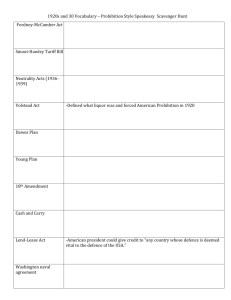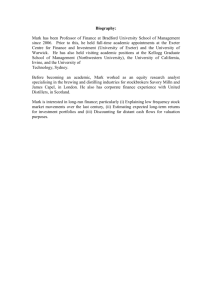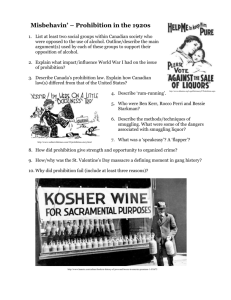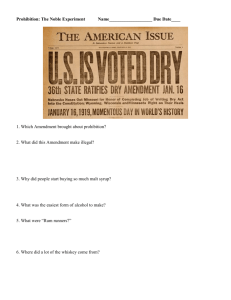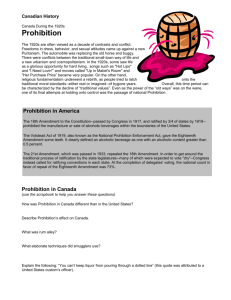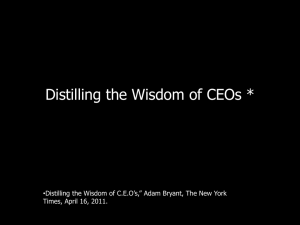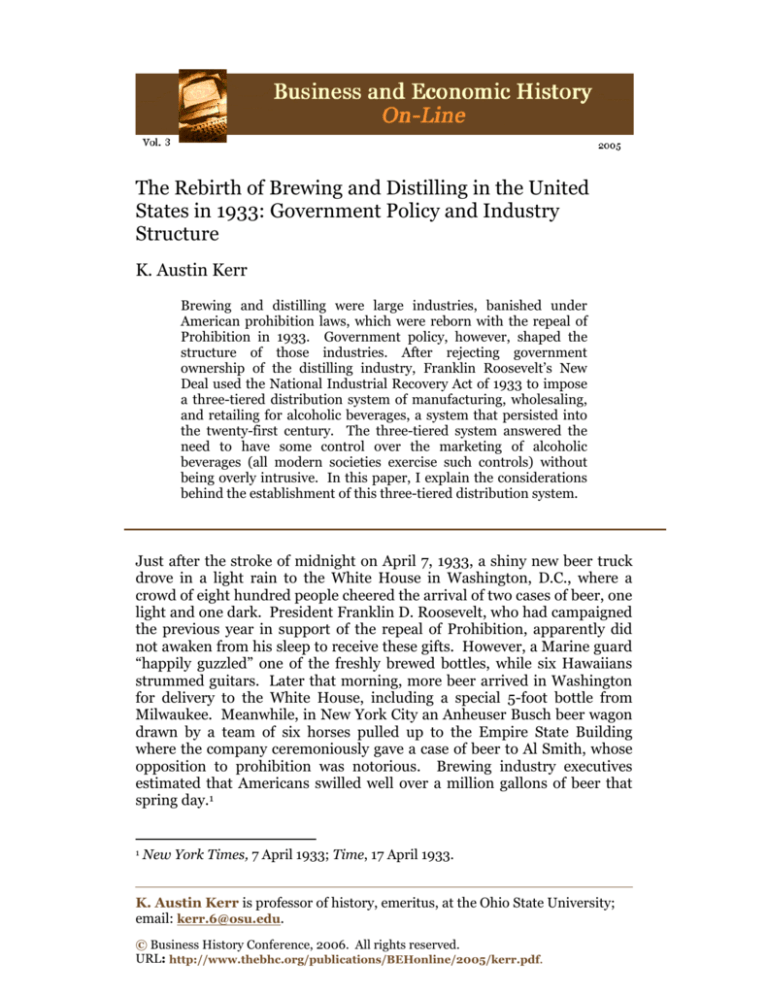
The Rebirth of Brewing and Distilling in the United
States in 1933: Government Policy and Industry
Structure
K. Austin Kerr
Brewing and distilling were large industries, banished under
American prohibition laws, which were reborn with the repeal of
Prohibition in 1933. Government policy, however, shaped the
structure of those industries. After rejecting government
ownership of the distilling industry, Franklin Roosevelt’s New
Deal used the National Industrial Recovery Act of 1933 to impose
a three-tiered distribution system of manufacturing, wholesaling,
and retailing for alcoholic beverages, a system that persisted into
the twenty-first century. The three-tiered system answered the
need to have some control over the marketing of alcoholic
beverages (all modern societies exercise such controls) without
being overly intrusive. In this paper, I explain the considerations
behind the establishment of this three-tiered distribution system.
Just after the stroke of midnight on April 7, 1933, a shiny new beer truck
drove in a light rain to the White House in Washington, D.C., where a
crowd of eight hundred people cheered the arrival of two cases of beer, one
light and one dark. President Franklin D. Roosevelt, who had campaigned
the previous year in support of the repeal of Prohibition, apparently did
not awaken from his sleep to receive these gifts. However, a Marine guard
“happily guzzled” one of the freshly brewed bottles, while six Hawaiians
strummed guitars. Later that morning, more beer arrived in Washington
for delivery to the White House, including a special 5-foot bottle from
Milwaukee. Meanwhile, in New York City an Anheuser Busch beer wagon
drawn by a team of six horses pulled up to the Empire State Building
where the company ceremoniously gave a case of beer to Al Smith, whose
opposition to prohibition was notorious. Brewing industry executives
estimated that Americans swilled well over a million gallons of beer that
spring day.1
1
New York Times, 7 April 1933; Time, 17 April 1933.
K. Austin Kerr is professor of history, emeritus, at the Ohio State University;
email: kerr.6@osu.edu.
© Business History Conference, 2006. All rights reserved.
URL: http://www.thebhc.org/publications/BEHonline/2005/kerr.pdf.
K. Austin Kerr // Rebirth of Brewing and Distilling in the U.S.
2
The excitement over the return of beer was part of a larger optimism
about the repeal of Prohibition and the rebirth of two major industries:
distilling and brewing. Advocates of repeal waxed rhapsodic over the
creation of new jobs, the flow of tax dollars to public treasuries, and new
markets for American farmers. Part of the appeal of Prohibition had
rested on the proposition that abstinence led to savings, and hence to
prosperity, a view that had carried great weight as late as 1930. However,
as the onset of the Great Depression darkened the American economy in
1931 and 1932, the prosperity argument was turned on its head to support
the repeal of Prohibition. The national Democratic Party stood for repeal
in 1932, and part of its promise of a “new deal” was drastic change in the
national alcohol laws.2
The optimism extended to hardheaded business executives and
investors. “Smart money” was going into the stocks of new and
reorganized distilling companies, while the breweries, which were more
often privately held than distilleries, announced massive investments.
Everyone, public official and private executive, thought that America was
thirsty and that Prohibition had been wildly unsuccessful, as even the
fictional George Babbitt went to Zenith’s Oberlin Avenue to purchase his
supplies from a local bootlegger. Prohibition, in this view, had been the
misguided work of “cranks” and “church ladies” whose principal desire
was to impose their morality on the public. The public had resisted and
now, finally, the stars in the political constellation had aligned for the
rebirth of the liquor industries. Congress initiated the Twenty-first
Amendment once the Democrats took power, and the states rushed to call
special ratification conventions. Of the death of Prohibition, there was no
doubt; the only question was which state would have the honor of driving
the final nail into its coffin. The promise of renewal seemed bright indeed.
The optimism surrounding the repeal of Prohibition, however, soon
dashed up against two realities, both of which restrained the rebirth of the
liquor industries. The first reality was that Americans were not as thirsty
for liquor as both investors and government officials thought. Simply put,
Prohibition had “worked”; the dry laws, however imperfectly enforced or
obeyed, had substantially reduced the consumption of alcoholic beverages.
This marketing reality meant that investors had to win back consumers if
they were to realize their profit ambitions and that government officials
would have to be complicit in those efforts if they were to reap the bonanza
of higher employment and tax revenues that the repeal movement had
promised. Both ambitious industrialists and revenue-hungry government
officials were very slow to recognize this situation, however.3
David Kyvig, Repealing National Prohibition (Chicago, 1979) is the standard
work on the repeal of the Eighteenth Amendment.
3 Those in the field of alcohol studies have known about the reduction of
consumption under Prohibition for many years, but this knowledge has been slow
to penetrate consciousness outside specialized historical circles. See my essay
2
K. Austin Kerr // Rebirth of Brewing and Distilling in the U.S.
3
The second reality for leaders in the liquor industries was that
government officials, however sympathetic and cooperative, were
determined to regulate the industries’ marketing behaviors. President
Roosevelt shared the conviction held by many political leaders, and even
some leaders in the liquor industries, that the prohibition movement
remained a powerful force in American life, still capable of much mischief.
In their view, the federal government must construct a framework for
fostering public-private partnerships with the brewing and distilling
industries, a framework that would ensure reformed marketing structures.
The big problem that fueled the flames for prohibition was what Franklin
Roosevelt and others called “the old-time saloon,” and government and
industry must work together to prevent its reappearance.4 The difficulty
with the old marketing structure, in their eyes, was that saloons were too
ubiquitous and too often associated with various criminal or otherwise
unseemly activities.5 The structure of control, moreover, was in this view
also a matter of federal-state cooperation, with the states free to set their
“American Dream,” New Scientist (27 Nov. 1999; End of the Millennium Special
Edition Alcohol: The Inside Story): 94-95.
4 Roosevelt had restated his position very clearly in the 1932 presidential
campaign. New York Times, 6 Feb. 1932. Roosevelt’s papers in the Franklin D.
Roosevelt Library indicate that he was personally involved in alcohol policy after
his inauguration. His statement proclaiming the enactment of the Twenty-first
Amendment and the end of Prohibition called for, among other things, policies
that would support an orderly transition to legal businesses. Franklin D.
Roosevelt, The Public Papers and Addresses of Franklin D. Roosevelt, 13 vols.
(New York, 1938-50), 2: 511-14.
The informed public agreed with Roosevelt in his admonition against “the
old-time saloon.” When John D. Rockefeller, Jr., commissioned a report for
alcohol control policies in anticipation of repeal, its authors explicitly condemned
“tied houses.” Vertical integration between distiller or brewer and retailers was
“responsible for the bad name of the saloon” with “all the vices of absentee
ownership” where the supplier cared little for what happened in the community.
They also observed that “almost every beer and general liquor law” enacted in
1933 at the state level included provisions to prevent “tied houses.” The
recommendations were released to the press in early Oct. 1933 in time to
influence federal policy; see Raymond B. Fosdick and Albert L. Scott, Toward
Liquor Control (New York, 1933), 43-44.
5 The author of a recent study of the old saloons emphasizes that they were
agencies that helped men accommodate to the harsh realities of urban and
industrial life, a sort of “working man’s club.” These saloons were dying
institutions even before Prohibition, as other forms of amusement started to take
their place; see Madelon Powers, Faces Along the Bar: Law and Order in the
Workingman’s Saloon, 1870-1920 (Chicago, 1998). Whatever the case, beer
manufacturers owned most pre-Prohibition saloons, and competition among
them led to their proliferation. With the resulting very small pool of customers
per saloon, retailers sometimes turned to illicit sources of income.
K. Austin Kerr // Rebirth of Brewing and Distilling in the U.S.
4
own policies, which, of course, could include a continuation of
prohibition.6
The brewers faced these realities before the distillers did, because
Congress authorized the manufacture and sale of low-alcohol beer in April
1933. Dispute soon wracked the brewing industry. Prohibition had
hastened the long-term trend of consolidation in brewing, and only about
160 firms reappeared in 1933. Some were established companies, like
Anheuser Busch of St. Louis or Pabst of Milwaukee, that had distributed
their products to national and even international markets. Other firms
were local or regional breweries, some of which arose during Prohibition
to manufacture “near beer” that fell under the low alcohol tolerance of the
enforcement statutes. All had struggled to survive during Prohibition,
either with new products like “near beer” or with old products like
refrigeration and yeast services. Before Prohibition there had been a great
deal of rivalry among the local, regional, and national “shipping”
breweries, rivalries that had led to bitter disagreements over regulation.7
The differences among brewers, moreover, were of first importance in
1933, as the distilling industry did not become legal until the formal repeal
of Prohibition on December 5. The Cullen Bill had authorized brewing in
April 1933 by changing provisions in the Prohibition enforcement statute.
During the intervening eight months, brewers had the legal alcoholic
beverage market almost to themselves, shared only with the small
quantities of wine that Americans drank. The brewers attempted a scheme
of self-regulation under the leadership of their trade association, the U.S.
The Cullen Bill placed brewing oversight in the hands of the Bureau of
Industrial Alcohol, and taxation matters in the Bureau of Internal Revenue, both
part of the Treasury Department. Treasury officials had a long history of
involvement with the liquor industries through taxation, and for most of the
Prohibition period enforcement of the Volstead Act resided in Treasury.
7 I am greatly indebted to Professor Lloyd Sponholtz of the University of Kansas,
whose unpublished paper, “Brewers and the NIRA: An Experiment in SelfRegulation,” is based on extensive reading in the trade press, as well as in
primary materials in the National Archives of the United States. Part of the
problem was ethnic: the brewing firms were all rooted in the German-American
experience. This background led to much self-delusion during the onslaught of
the prohibition reform movement. In the brewers’ culture, beer was a benign
beverage, “liquid bread” that did not lead to intoxication; see Robert G. Laforge,
“Misplaced Priorities: A History of Federal Alcohol Regulation and Public Health
Policy” (Ph.D. diss., Johns Hopkins University, 1987), 178-79. In this view
distilled spirits, not beer, caused the problems associated with alcohol use.
Although brewing and distilling interests could act in concert at the local level to
repeal dry laws, they never agreed on a national strategy to fight the
prohibitionists. Some brewers even thought that Prohibition would not fall on
them, but only on the distillers. These old attitudes had not disappeared in 1933;
after repeal the two industries remained bitter commercial rivals for the business
of drinkers.
6
K. Austin Kerr // Rebirth of Brewing and Distilling in the U.S.
5
Brewers’ Association (USBA), and the National Industrial Recovery Act
provisions for “codes of fair competition.” The USBA, which represented
just over 60 percent of the industry’s capacity, tended to voice the interests
of the larger firms. Some of those firms had established “tied houses,” as
the vertical integration of manufacturing and retailing was called in
brewing prior to Prohibition, and with the Cullen Bill they sometimes
reopened old relationships in real estate, financing, advertising, and the
like. Nevertheless, clearly the industry could not allow a return to the old
conditions: the government would not stand for it, and many brewers
recognized its political folly.
Therefore, under USBA leadership the brewers drafted a code, which
proposed a three-tiered distribution system of manufacturer, wholesaler,
and retailer, required for everyone in the industry. Structured to prevent
the return of the “old-time saloon,” the system forbade “tied houses,” with
one caveat: arrangements in place prior to September 1, 1933 would be
allowed to continue.
Some smaller brewers immediately cried foul. They tended to belong
to the American Brewers’ Association (ABA), if they were members of any
trade association. They voiced their views to the New Dealers who were
ultimately to approve the code for the industry.8 The smaller brewers
feared domination by the large firms, who seemed to be placing
themselves at a competitive advantage with the September 1 rule, which
would make it more difficult for a small firm to gain any significant
foothold in the beer market.
When this dispute emerged in the late summer, the beer market also
proved desultory. The high optimism leading up to the passage of the
Cullen Bill, and the publicity stunts after its passage, had faded in the face
of dampened consumer spending amid the Great Depression. Beer
marketers were also beginning to learn that Americans were not as thirsty
for beer as they had assumed. Although the remaining beer market was
substantial, it was smaller than industry leaders and government officials
had expected.9 In the face of this situation, the brewers continued
In this case, it was Secretary of Agriculture Henry A. Wallace. The code for the
brewing and distilling industries fell under the auspices of the Agricultural
Adjustment Administration, which Wallace headed. Wallace had supported
Prohibition and was clear in his demand that former saloon conditions not
reappear.
9 In fact, the per capita alcohol consumption of the drinking-age population did
not return to its pre-Prohibition levels until the early 1970s. Clearly, the market
problems were not solely a result of the Depression; during the depression of the
1890s, the nation’s previous experience with a sustained downturn, beer
consumption rose.
8
K. Austin Kerr // Rebirth of Brewing and Distilling in the U.S.
6
operating in self-delusion. The problem was elsewhere: taxes were too
high, or bootleggers were still slaking demand.10
The brewers were simply unable to agree on a code, and eventually the
government imposed one on them. Noting the lack of a code in brewing,
and observing the likelihood of Prohibition’s repeal, Roosevelt expressed
his desire for the formation of a special interdepartmental committee to
formulate alcohol policy.11 The President’s Special Committee, as the body
was known, worked quickly to draft codes of fair competition.12 Its efforts
with regard to the distilling industry set the basic shape of federal policy
and, eventually, important structural aspects of all alcoholic beverage
businesses. By the end of November, furthermore, as the repeal surge
swept the nation and national Prohibition’s death seemed imminent,
Roosevelt decided to create the Federal Alcohol Control Administration
(FACA) with an executive order, using authority granted in the National
Industrial Recovery Act of 1933. He chose “an old friend,” Joseph Choate,
a Manhattan attorney active in the repeal movement, to head the new
agency. The press quickly labeled Choate “liquor czar.” The FACA also
had a controlling board that included Harris E. Willingham of the
Agricultural Adjustment Administration (AAA), and high officials in the
departments of State, Justice, Commerce, and Treasury.13
They also worried that an entire generation of potential customers who had
come of age under Prohibition had not learned the taste of beer.
11 This committee resulted from an informal meeting with George N. Peek, head
of the Agricultural Adjustment Administration. The codes of fair competition
that eventually resulted from these processes fell under the AAA, because the
liquor industries were consumers of farm products. The President’s Special
Committee on the Control of Alcohol and Alcoholic Beverages included Harris E.
Willingham of the Department of Agriculture, Frank M. Parish of the Department
of Justice, John Wiley of the Department of State, Willard L. Thorp of the
Department of Commerce, with Herman Oliphant of the Department of Treasury
as chairman and Edward S. Greenbaum of Treasury as acting chairman. Harris
E. Willingham, Chief, Beverages Section, Agricultural Adjustment Administration, “Report to the Administrator for the Period from October 9 to Dec. 31,
1933,” Records of the Agricultural Marketing Service, Reference File of John E.
Dalton, Chairman, Alcoholic Beverages Committee of the Agricultural
Adjustment Administration, 1933-35, Record Group 136, National Archives of the
United States. Repeal of Prohibition was occurring more quickly than most
observers had expected; officials earlier in 1933 thought that repeal would not
occur until sometime in 1934. The speed of the repeal surge meant that
formulating alcohol policy was all the more urgent.
12 Staff members in the Department of Agriculture did the actual drafting. Harris
Willingham was the central figure. Henry A. Wallace to Roosevelt, 22 Jan. 1935,
Office File 796, FDR library.
13 New York Times, 30 Nov. 1933.
The Executive Order was available at
http://www.uhuh.com/laws/donncoll/eo/1933/EO6474.TXT on 1 May 2005.
Willingham was “primarily responsible” for writing the codes of fair competition
for the distilling industry.
10
K. Austin Kerr // Rebirth of Brewing and Distilling in the U.S.
7
Prior to these organizational decisions, however, the Roosevelt
administration considered another alternative for the reborn liquor
industries: public ownership. Officials in the Department of Agriculture,
led by Jerome Frank, proposed a “Federal Alcohol Corporation” governed
by the Secretaries of State, Commerce, Treasury, and Agriculture. The
corporation would cover all distilled spirits, fortified wines and beers,
imported wines, and industrial alcohol, but not domestically produced
wine or unfortified beer. It would actually own distilleries and handle all
aspects of those liquor trades, and the industrial alcohol business, except
that existing firms could continue under license from the federal
corporation. The advantages seemed manifold, including the possible
introduction of alcohol blended with gasoline as a motor fuel, interest in
which continued in the face of mounting grain surpluses. Roosevelt
rejected the idea in late November, however; the rebirth of all liquor
industries in the United States would occur under private ownership.14
The rebirth would also occur under codes of fair competition, codes
that the government imposed on the industries. When the federal
government dealt with the code of fair competition for the distilling
industry, it established a pattern for controlling the entire field of alcoholic
beverages. Although the distillers had formulated a code themselves, the
President’s Special Committee on Alcohol wrote its own code. The final
code was a result of negotiation, but government officials were the key
figures in its formulation. Perhaps the most important aspect of the code
was the establishment of the Federal Alcohol Control Administration. The
FACA would use the services of the Agricultural Adjustment Administration, the Bureau of Internal Revenue, and the Food and Drug
Administration, among other agencies. This feature made it unlike other
codes of fair competition constructed in 1933; like those other codes,
however, it did provide for an industry-appointed Code Authority to
administer the code provisions that did not fall under the purview of the
FACA. Although there was to be no federal ownership of distilleries and
wholesalers, the director of the FACA would both issue permits
authorizing distilleries and control future expansion of production
capacity.15 Thus distilling, in this scheme, would involve a public-private
partnership, with the government exercising ultimate authority over basic
production investments. Alcohol, clearly, was not to be treated with the
“Proposed Federal Alcohol Corporation,” 20 Nov. 1933, Office File 796, FDR
Library. For further discussion of public ownership considerations, see Pamela
E. Pennock and K. Austin Kerr, “In the Shadow of Prohibition: American
Domestic Alcohol Policy Since 1933,” Business History 47 (July 2005): 383-400.
15 George N. Peek to Henry A. Wallace, 25 Nov. 1933, Code of Fair Competition
for the Distilled Spirits Industry (Washington D.C., 1935), 18-19. One reason for
the permit system was to keep “racketeers” and other criminal elements out of
the distilling business.
14
K. Austin Kerr // Rebirth of Brewing and Distilling in the U.S.
8
same New Deal policies as those of other businesses under the National
Industrial Recovery Act.
The distilling industry code also established a three-tiered system of
manufacturers, wholesalers, and retailers with strict limitations to ensure
separation of the three functions. Manufacturers could not provide goods
for domestic sale on consignment (foreign consignment sales were
allowed, as New Deal officials sought to expand American exports as well
as to use the domestic American alcohol market as a bargaining chip in
international economic negotiations) or compensate wholesalers or
retailers for advertising costs. In other words, a domestic distributor had
to take title to the product upon receiving it. There was to be no return of
what Roosevelt and other leaders termed the “old-time saloon”; distillers
could not hold any license or real estate interests in retailers who sold
spirits for consumption on their premises.16
The distillers did not object publicly to these provisions, but the
brewers, once they saw the pattern set, were another matter. In March
1933, anticipating the quick legalization of beer, the editors of Western
Brewer scoffed at shibboleths about the “old-time saloon” and picked
apart any efforts to define that institution. The faults that had led to
Prohibition, they convinced themselves, were the result either of actions of
the spirits industry or of the behavior of customers, not a result of the
vertical integration of marketing in their industry. When they proposed
their own regulations, the editors suggested all marketing controls rest
with the state governments, which might best require retailers to have
comfortable chairs and tables for the leisurely consumption of their “nonintoxicating beverage.”17 Late in December, brewing industry leaders and
the editors of Brewery Age bitterly objected when federal officials rejected
the industry’s own code in favor of placing the brewing industry under the
FACA. Brewing and distilling, in their eyes, were separate industries and
commercial rivals that should not be the subject of independent oversight.
After all, unlike spirits, they did not consider beer intoxicating.18
George Peek, as head of the Agricultural Adjustment Administration,
explained the genesis of the final code for brewing. They had not followed
all of the usual procedures in adopting the brewers’ code in the interests of
having a code in place when Prohibition was repealed. The final code was
a compromise between the administration’s code and the brewers’ code. A
central difference was that the brewers, like the distillers, would operate
Code of Fair Competition for the Distilled Spirits Industry (Washington, D.C.,
1935), Article VII.
17 “How Should Beer Be Regulated,” Western Brewer 69 (March 1933): 22-24;
“Avoid the Evils of the Old Time Saloon,” ibid., 27-28.
18 Press Release, 28 Nov. 1933, Brewers Code File, Records Relating to Codes of
Fair Competition, Records of the Office of the Solicitor, Department of
Agriculture, Record Group 16, National Archives.
16
K. Austin Kerr // Rebirth of Brewing and Distilling in the U.S.
9
under the supervision of the FACA. The code’s oversight committee was to
have representatives of the USBA and the ABA, but brewers who were not
members of either association were to elect a majority. Regional bodies, a
feature much desired by an industry fractured between local, regional, and
national producers, would decide most disputes.
Two features stood out in this code. First, unlike the controls over
distilling, there was to be no restriction of entry into the brewing business.
Clearly all parties concerned thought that the business would expand;
there was no need to restrict the volume of production. In this sense,
government policy favored brewers over distillers. Second, the code
governed distribution in anticipation of a separate code for wholesaling.
Distributors had to follow this code in the meantime.
The code was strict in its control over brewer marketing practices.
Following the provisions of the earlier distilling code, the code forbad
brewery ownership of retail outlets and shipping products on
consignment.19 With regard to retail sales, brewers were forbidden to own,
“directly or indirectly,” any license to sell products where they were
consumed. Any existing licenses would be honored but could not be
renewed. The manufacturers could not “furnish, give, or lend any money
or other thing of value, directly or indirectly” to any retailer. The brewers
could not furnish equipment in any fashion and there were strict limits on
signs. Brewers could not require a retailer to sell only their products and
could not own real estate at the point of retail sale.20
A separate code for liquor wholesaling quickly followed. Because it
immediately followed Prohibition’s repeal, the code did not include the
usual labor provisions. Unlike the brewing and distilling codes, the
wholesale code emerged without a private trade association suggesting any
provisions.21 It also separated the wholesaling of beer and of spirits. The
President’s Committee once again made clear its demand for the
establishment of a three-tiered distribution system. Like the manufacturers, the distributors were not to own or control any retail outlets
where there was consumption of any form of liquor on the premises. Gone
was the business of the rectifiers, who before Prohibition had purchased
spirits in bulk before blending and packaging them. The wholesale code
George N. Peek to Franklin D. Roosevelt, 4 Dec. 1933, Federal Alcohol Control
Administration, Code of Fair Competition for the Brewing Industry
(Washington, D.C., 1935), appendix A, 15-17.
20 Code of Fair Competition for the Brewing Industry, Article IV, 3-6.
21 In transmitting the distilling and brewing codes for approval, Peek had
included comments about industry input. There were no such comments in this
case. George N. Peek to Henry A. Wallace, 8 Dec. 1933, Code of Fair Competition
for the Alcoholic Beverage Wholesale Industry (Washington, D.C., 1935), 18.
Although there was a trade association for wholesalers and rectifiers (businesses
that blended and bottled whiskies) before Prohibition, it may not have resurfaced
to participate in the 1933 negotiations.
19
K. Austin Kerr // Rebirth of Brewing and Distilling in the U.S.
10
forbade any purchase in bulk outside of bottles and separated the
distribution of beer and spirits with different provisions. Wholesalers
dealing in spirits and those dealing in beer were to form their own code
authority, but that code authority would have separate committees for
each type of product.22
Thus, the decisions of federal officials in the immediate aftermath of
Prohibition decided the structure of two important industries, distilling
and brewing.23 Although those decisions were somewhat controversial
among the business executives concerned, they also enjoyed considerable
support. They reflected an understanding of the motives and practices
that had fueled the drive for Prohibition, the vertical integration of
manufacturing and retailing in the brewing industry. Before Prohibition,
the saloon had proliferated—largely because of competition among
brewers—and become a social sore in the eyes of many Americans. Those
brewers who recognized the problem before Prohibition agreed with the
general policy of creating a three-tiered distribution system of manufacturers, wholesalers, and retailers.24
The three-tiered structure proved to be a lasting one. Many states also
adopted new liquor policies during the immediate aftermath of Prohibition
that further enshrined the three-tiered structure. It has lasted into the
twenty-first century in federal law. Manufacturers of liquor may not participate in either the wholesaling or the retailing of alcoholic beverages in
the United States.
Code of Fair Competition for the Alcoholic Beverage Wholesale Industry.
When Congress passed the District of Columbia Alcoholic Beverage Control Act
on 24 Jan. 1934, it explicitly required a three-tiered distribution system. Gilman
G. Udell, Liquor Laws (Washington, D.C., 1978), 105-6.
24 K. Austin Kerr, “The American Brewing Industry, 1865-1920,” in The
Dynamics of the International Brewing Industry Since 1800, ed. Richard Wilson
and Terry Gourvish (London, 1998), 176-92.
22
23


